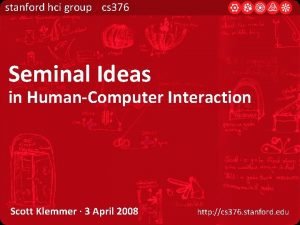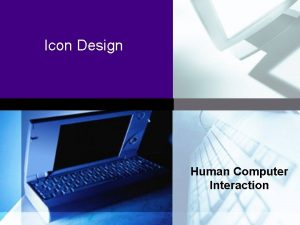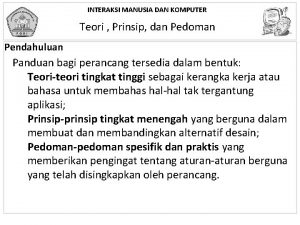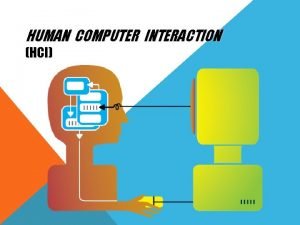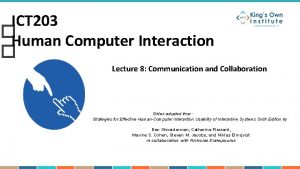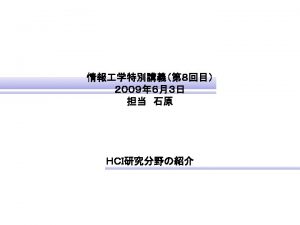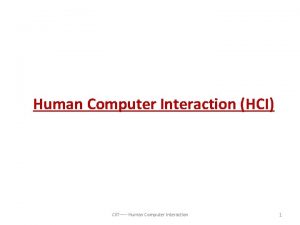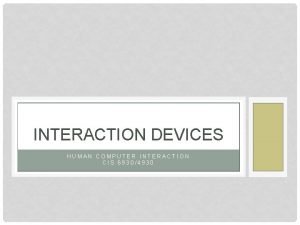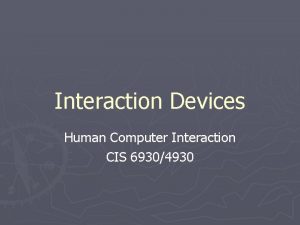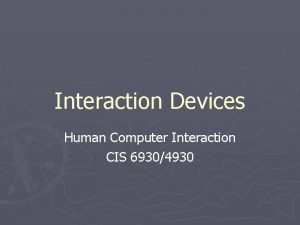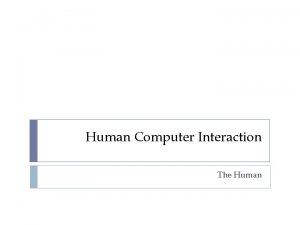ICT 203 Human Computer Interaction Lecture 7 Interaction

















- Slides: 17

ICT 203 � Human Computer Interaction � Lecture 7: Interaction - Design Case Studies Slides adopted from: Strategies for Effective Human-Computer Interaction Usability of Interactive Systems Sixth Edition by Ben Shneiderman, Catherine Plaisant, Maxine S. Cohen, Steven M. Jacobs, and Niklas Elmqvist in collaboration with Nicholas Diakopoulos

Learning Outcomes � 1. � 2. Introduction Case Study 1: Iterative Design Evaluation of Automated Teller Machines 3. Case Study 2: Design Consistency at Apple Computer 4. Case Study 3: Data-Driven Design at Volvo 5. General Observations and Summary CRICOS 03171 A

Case Study 1: Iterative Design Evaluation of Automated Teller Machines (ATMs) � � • The scope of this Case Study is physical ATMs an example of which appears here: The case studies are valuable for encapsulating design learning and showing the challenges of a design context. CRICOS 03171 A

Case Study 1: Iterative Design Evaluation of ATMs (continued) �Visualize the statistical data that can be captured from this usability “experiment”: � • Time to complete entire tasks over a statistically significant set of ATMs • Time expended for these ATM steps or “subtasks” • Objective and subjective user feedback and contextual observation regarding user performance of the above ATM steps. CRICOS 03171 A

Case Study 1: Iterative Design Evaluation of ATMs (concluded) �Add additional requirements and technology to further complicate your analysis: • Use eye-tracker data to further analyze the product � • Consider user profile issues, e. g. is the first time this user is using an ATM by herself? • Are there other stresses such as a looming time deadline or a safety issue? CRICOS 03171 A

Case Study 2: Design Consistency at Apple Computer �See the i. OS Human Interface Guidelines in the i. OS Developer Library Here are some sample guidelines: � – Take advantage of the whole screen – Reconsider visual indicators of physicality and realism – Let color simplify the user interface – Use depth to communicate CRICOS 03171 A

Case Study 2: Design Consistency at Apple Computer (continued) � • Note the application of these UI guidelines to Apple’s Keynote. TM product Keynote has presentation development tools, graphics and toolbars for rapid generation of presentations CRICOS 03171 A

� � Case Study 2: Design Consistency at Apple Computer (continued) Sample Keynote display with help text: CRICOS 03171 A

Case Study 2: Design Consistency at Apple Computer (continued) � � CRICOS 03171 A

� • � Case Study 2: Design Consistency at Apple Computer (concluded) Rapid device technology improvements (lighter weight, faster, more colors, more pixels, improved throughput, etc. ) result in a constant re-evaluation of the user interface and improvements of the guidelines applied CRICOS 03171 A

Case Study 3: Data-Driven Design at Volvo � • � Volvo's Big Data service provides a terrific example of a case study with Big Data analytics used in the corporate world that contains a strong user-interface design component. * CRICOS 03171 A

Case Study 3: Data-Driven Design at Volvo (continued) � � • A multi-disciplinary, crossorganizational stakeholder team developed this lowfidelity prototype: CRICOS 03171 A

Case Study 3: Data-Driven Design at Volvo (continued) � � • Through a series of refinements, this prototype evolved into something useful for all concerned: CRICOS 03171 A

Case Study 3: Data-Driven Design at Volvo (concluded) • The performers of the study learned to first identify sources of data, while � � empowering the stakeholders of the data to choose what data they could use (and how) in order to get their jobs done. – The final result was corporate Big Data policies that led to stakeholdercustomizable report formats to better improve internal corporate communication and decision-making. CRICOS 03171 A

Case Study General Observations � • � These case studies are “a tip of the iceberg” in what can be accomplished by designers of user interface systems • The case studies were chosen strategically to highlight design contexts, various applications, and incremental continuous improvement – The ATM design – The Apple Guidelines – The Volvo study CRICOS 03171 A

Summarize the important points � 1. Discuss how case study is helpful. � 2. Identify some of the interaction devices from day to day life. CRICOS 03171 A

THANK YOU !! CRICOS 03171 A 17
 Mit csail hci course review
Mit csail hci course review Interaction design icon
Interaction design icon What are paradigms in hci
What are paradigms in hci Human outputs
Human outputs History of human computer interaction
History of human computer interaction Direct manipulation example
Direct manipulation example Hci chapter 1
Hci chapter 1 Pola pikir desainer imk dibawah ini adalah
Pola pikir desainer imk dibawah ini adalah Prinsip imk
Prinsip imk Human computer interaction syllabus
Human computer interaction syllabus Pengertian interaction
Pengertian interaction Human computer interaction dix
Human computer interaction dix Human computer interaction diagram
Human computer interaction diagram Ergonomics in human computer interaction
Ergonomics in human computer interaction Definition of human computer interaction
Definition of human computer interaction 01:640:244 lecture notes - lecture 15: plat, idah, farad
01:640:244 lecture notes - lecture 15: plat, idah, farad Human resources department structure
Human resources department structure Intro to human resource management
Intro to human resource management
